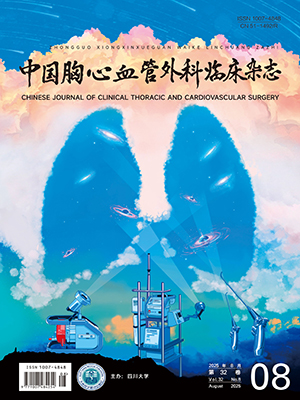| 1. |
Zhang K, Shang J, Chen Y, et al. The prognosis and risk factors for acute kidney injury in high-risk patients after surgery for type A aortic dissection in the ICU. J Thorac Dis, 2021, 13(7): 4427-4437.
|
| 2. |
Li L, Zhou J, Hao X, et al. The incidence, risk factors and in-hospital mortality of acute kidney injury in patients after surgery for acute type A aortic dissection: A single-center retrospective analysis of 335 patients. Front Med (Lausanne), 2020, 7: 557044.
|
| 3. |
生伟, 栾天, 池一凡, 等. 急性Stanford A型主动脉夹层术后急性肾功能损伤的危险因素分析. 中国胸心血管外科临床杂志, 2019, 26(1): 67-72.
|
| 4. |
Kim WH, Lee JH, Kim E, et al. Can we really predict postoperative acute kidney injury after aortic surgery? Diagnostic accuracy of risk scores using gray zone approach. Thorac Cardiovasc Surg, 2016, 64(4): 281-289.
|
| 5. |
Khwaja A. KDIGO clinical practice guidelines for acute kidney injury. Nephron Clin Pract, 2012, 120(4): c179-c184.
|
| 6. |
Yu Y, Lyu Y, Jin L, et al. Prognostic factors for permanent neurological dysfunction after total aortic arch replacement with regional cerebral oxygen saturation monitoring. Brain Behav, 2019, 9(7): e01309.
|
| 7. |
Norton EL, Khaja MS, Williams DM, et al. Type A aortic dissection complicated by malperfusion syndrome. Curr Opin Cardiol, 2019, 34(6): 610-615.
|
| 8. |
焦瑞, 刘楠. 急性StanfordA型主动脉夹层术后急性肾损伤患者连续性肾脏替代治疗后的死亡预后因素分析. 中华外科杂志, 2017, 55(4): 270-273.
|
| 9. |
Helgason D, Helgadottir S, Ahlsson A, et al. Acute kidney injury after acute repair of type A aortic dissection. Ann Thorac Surg, 2021, 111(4): 1292-1298.
|
| 10. |
Nakamura T, Mikamo A, Matsuno Y, et al. Impact of acute kidney injury on prognosis of chronic kidney disease after aortic arch surgery. Interact Cardiovasc Thorac Surg, 2020, 30(2): 273-279.
|
| 11. |
Tsai HS, Tsai FC, Chen YC, et al. Impact of acute kidney injury on one-year survival after surgery for aortic dissection. Ann Thorac Surg, 2012, 94(5): 1407-1412.
|
| 12. |
中国心脏重症连续性肾脏替代治疗专家共识工作组. 心脏外科围手术期连续性肾脏替代治疗专家共识. 中华医学杂志, 2019, 99(5): 321-328.
|
| 13. |
顾嘉玺, 邵永丰, 倪布清, 等. 急性Stanford A型主动脉夹层孙氏手术后院内死亡危险因素分析. 南京医科大学学报(自然科学版), 2020, 40(8): 1194-1197.
|
| 14. |
Conzelmann LO, Weigang E, Mehlhorn U, et al. Mortality in patients with acute aortic dissection type A: Analysis of pre- and intraoperative risk factors from the German Registry for Acute Aortic Dissection Type A (GERAADA). Eur J Cardiothorac Surg, 2016, 49(2): e44-e52.
|
| 15. |
杨志刚, 罗进光. 急性Stanford A型主动脉夹层术后早期死亡危险因素及nomogram模型构建. 中国循证心血管医学杂志, 2021, 13(7): 799-802.
|
| 16. |
Jussli-Melchers J, Panholzer B, Friedrich C, et al. Long-term outcome and quality of life following emergency surgery for acute aortic dissection type A: A comparison between young and elderly adults. Eur J Cardiothorac Surg, 2017, 51(3): 465-471.
|
| 17. |
Wang Z, Ge M, Chen T, et al. Risk factors and long-term outcomes of elderly patients complicating with acute kidney injury after type A acute aortic dissection surgery: A retrospective study. J Thorac Dis, 2020, 12(10): 5833-5841.
|
| 18. |
Xu S, Liu J, Li L, et al. Cardiopulmonary bypass time is an independent risk factor for acute kidney injury in emergent thoracic aortic surgery: A retrospective cohort study. J Cardiothorac Surg, 2019, 14(1): 90.
|
| 19. |
Ge H, Jiang Y, Jin Q, et al. Nomogram for the prediction of postoperative hypoxemia in patients with acute aortic dissection. BMC Anesthesiol, 2018, 18(1): 146.
|
| 20. |
Zhang K, Pan XD, Dong SB, et al. Cardiopulmonary bypass duration is an independent predictor of adverse outcome in surgical repair for acute type A aortic dissection. J Int Med Res, 2020, 48(11): 300060520968450.
|
| 21. |
Vlot EA, Verwijmeren L, van de Garde EMW, et al. Intra-operative red blood cell transfusion and mortality after cardiac surgery. BMC Anesthesiol, 2019, 19(1): 65.
|
| 22. |
Garg AX, Badner N, Bagshaw SM, et al. Safety of a restrictive versus liberal approach to red blood cell transfusion on the outcome of AKI in patients undergoing cardiac surgery: A randomized clinical trial. J Am Soc Nephrol, 2019, 30(7): 1294-1304.
|




